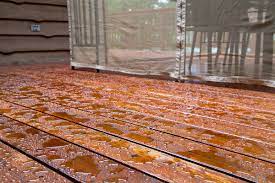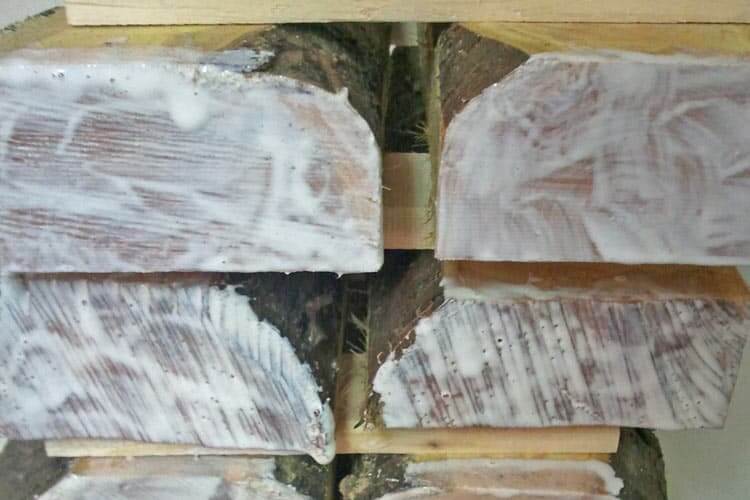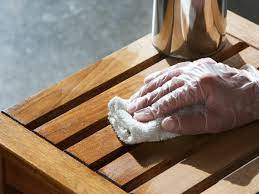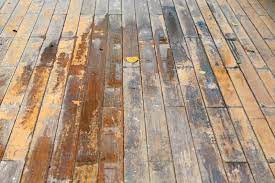Staining dry wood is a quick, straightforward process, and watching the surface soak up the stain is satisfying.
Unfortunately, you can’t say the same about wet wood. For instance, occasionally, you may have to deal with green wood, wet-treated wood, or the pressure to stain after a light rain or pressure washing a wooden surface. It’s extremely challenging to stain such wood.
So, below we explain a few tips to help you attain a somewhat quality finish when staining wet wood. We also answer common questions, such as can you stain wet wood?
Can You Stain Wet Wood?
Yes, you can stain wet wood. However, the stain won’t penetrate the wood evenly and will likely result in an ineffective finish. Besides, wet wood has a lot of moisture, so it will take longer to dry. In some cases, however, staining wet wood can achieve a specific effect, such as a weathered look.
Learn more here, what happens if you stain wet wood?
Why Doesn’t Stain Stick to Wet Wood?
Wood stain or paint doesn’t easily stick to wet wooden surfaces because all the wood pores are filled with water or moisture.
You see, wood stains “stick” to wood surfaces by penetrating the wood grain via tiny holes (pores) on the wood surface. It’s similar to how wood becomes damp after exposure to humid conditions.
Unfortunately, wet wood contains substantial amounts of wood oils and tannins. Alternatively, the surface would have lots of water if you’re dealing with recently-washed dry wood.
Indeed, the dry wood may have absorbed some of the water, filling up the wood pores. As a result, the wood stain has nowhere to go because the wood pores are already filled with moisture or water.
And, as we’ve seen, wood stain cannot stick to the surface if it cannot penetrate the wood pores. The problem is worse when using oil-based stains because the solvent (oil) doesn’t mix with water.
What Happens if You Stain a Wet Deck?
Staining a wet deck opens a can of worms. The following are a few issues that may come up if you stain the surface without first drying it;
- Difficult in prepping wood: It’s standard procedure to prep wood surfaces before staining, which involves cleaning and sanding. Unfortunately, you cannot properly clean or sand wet wood.
- Staining and bleeding: Most woods contain natural tannins, oils, and moisture. Imagine an extra layer of water trying to force its way into the wood and then a stain coat over the wet surface! The intense internal pressure would cause bleeding, characterized by yellowing in the finish.
- Longer drying time: Wood stains dry when the solvent evaporates. This process is fairly quick. However, a layer of water beneath the stain complicates the drying process as the water must evaporate and dry first. This often results in a longer drying time.
- Poor adhesion: We’ve seen that a wet surface prolongs the stain’s drying time. However, sometimes the solvent may not evaporate completely. If this happens, the stain may not stick to the surface strongly, resulting in peeling.
- Tacky or sticky stain: Stickiness and foul smells are other potential issues if the stain doesn’t dry completely.
Related Post: How Long for Deck Stain to Dry Before Rain

How Dry Does Wood Have to be to Stained?
Most manufacturers recommend a 12% to 15% moisture content for decks before staining.
The good news is that you can easily measure the moisture content of your wood boards using a moisture meter.
There are two types – pinless moisture meters and pin-type moisture meters – both of which display the moisture content as a percentage on the front screen.
- Pinless moisture meters: These devices, such as the BXUNDI Pinless Wood Moisture Meter, sit on the wood surface and use an electromagnetic sensor pad to measure the density of the wood to assess its moisture content.
- Pin-type moisture meters: Pin-type moisture meters, such as the General Store MMD4E Digital Moisture Meter, feature a pair of pins at the top. You need to force these pins into the wood to measure the electrical resistance between the two points. The higher the conductivity, the wetter the wood.
How Long to Let Wood Dry Before Staining
There’s no one-size-fits-all approach to drying wood before staining. Instead, you should work within your project’s conditions.
For instance, are you dealing with previously dried wood or green wood? Similarly, is it pressure-treated, kiln-dried, or untreated wood? These factors directly determine the amount of drying time required before staining wood.
- Drying green (untreated) wood before staining: The rule of thumb is to allow one year of drying time per inch of green wood before staining when air drying. This translates to nine months of drying time for 3/4-inch boards and two years for 2-inch planks.
- Drying green (treated) wood before staining: You should dry out pressure-treated wood for 30-90 days before staining.
- Drying time after a rain or chemical cleaning: Assuming the wood was previously dry before the rain or chemical cleaning process, you only need to wait two days before staining.
How to Tell if Wood is Dry Enough to Stain
Besides drying for the recommended period and measuring with a moisture meter, you should look out for the following signs to know the wood is sufficiently dry and ready for staining;
- The wood feels hard and dry: Dry wood feels hard and dry. On the other hand, wet wood is soft and moist.
- Moisture content below 15%: As we’ve said, dry wood returns a 15% or lower moisture content on a moisture meter.
- The wood doesn’t smell: Wet wood has a musty smell. But, conversely, dry wood doesn’t smell.
- Raised wood fibers and small splinters: Almost all dry wood boards have raised fibers and tiny splinters resulting from board shrinkage.
- The sandpaper test: The wood is sufficiently dry and ready for staining if you can sand the surface without the sandpaper becoming wet and sticky.

How to Apply Deck Stain to Damp Wood
You can gather the tools and materials and begin staining if you’ve determined that the wood is sufficiently dry. The following are tips, tricks, and guidelines to help you.
What are the Best Wood Stains for Wet Wood?
Most wood stains are okay. But water-based stains are better than oil-based stains as the water base readily mixes with the water in the wood.
You’ll notice that most deck stains are oil-based. Therefore, finding a deck stain for damp surfaces is not easy. So, we advise that you find moisture-resistant products when working on the deck. A moisture-resistant deck stain sticks to the surface because it’s formulated to overcome wet conditions.
However, be prepared for a low-quality finish, no matter your choice of deck stain. Adhesion is a particularly big challenge. As a result, the stain may not last as long as you’d wish. Also, the higher the wood’s moisture content, the worse the adhesion problems.
Other Post: Can Particle Board Be Stained?
How to Stain Damp Wood: Step-by-Step Guide
Requirements
- Stain-blocking paint primer
- A hairdryer
- Paintbrush and spray gun
- Waterproof sandpaper (220-grit)
- Drop sheets
- A pair of gloves
- A can of water-based stain
Step 1: Prepare for the project
Staining wet wood can be a messy job. So, you must take care of a few things before you get started.
First, you need plenty of space to work. So, carry the item outside if possible. Alternatively, move the objects around it to create space. Then place a large drop cloth sheet below the item to collect tannins and other debris falling off the project.
Step 2: Dry the wood
This is a critical step as the quality of the staining project depends on the dryness of the wood. So, you need to find ways to fast-dry the wood.
An excellent solution is a hairdryer. Turn on the hairdryer and move it over the surfaces of the wood project to increase evaporation. You’ll get even better results if you do so outdoors in the sun. The increased heat accelerates the drying process.
Step 3: Apply a stain-blocking primer
Once the surface has dried a little, apply the surface conditioning primer. Shellac primers are excellent choices as they prevent moisture in the wood from seeping out. This ensures better adhesion and a longer stain life. However, make sure to use a primer compatible with your stain.
Use the paintbrush to apply a light coat of the primer. Then wait 20 minutes for the first coat to dry before applying the second coat. You need 2-3 coats.
Step 4: Sand/scuff the wood surface
Wait until the stain-blocking primer has dried fully. Then lightly scuff the surface with fine-grit sandpaper to create a rough surface for maximum stain adhesion.
Use rags to wipe the surface after sanding to remove sanding dust that may interfere with stain adhesion.
Step 5: Apply the primer
We recommend a spray gun for this process, as a paintbrush may not achieve the best results. For instance, the damp wood can prevent the paintbrush from sliding smoothly across the surface. Moreover, spray guns are faster.
Allow the surface to dry for an hour after the first stain coat. Alternatively, use a hairdryer to accelerate the drying process. Then apply the second (and final) coat and let it dry for 24 hours. Now the surface is ready for use.
If you encounter issues later and wish to rectify your work, we have you covered. Refer to our comprehensive guide on fixing bad stain job for effective solutions and tips.
Tips to Apply Stain to Damp Wood
- Ideally, you want to wait until the wood is dry enough for staining. Only stain damp wood if you’re under serious time constraints.
- Prepping is the key to a good finish when staining wet woods. So, take your time here.
- Never stain wood that is visibly soaking wet. Instead, find ways to dry the surface, at least. A hairdryer is a good solution.
- Always begin by staining vertical surfaces while protecting the horizontal surfaces from excess stain.
- You only need one coat of stain for new decks less than a year old. Only apply two or three coats on older decks.
- All the stain needs to be absorbed into the wood. So, only apply as much stain as the surface can absorb and wipe the excess stain after a few minutes.
- Wet-on-wet stain manufacturers always provide detailed instructions on how to use their products. Follow the guidelines fully.

Interesting Read: Do You Need to Take Off the Old Stain Before Re-staining?
FAQs
How many days after it rains should you apply deck stain?
According to Behr deck stain makers, you should avoid staining a deck for 24-48 hours after it rains or the wood becomes wet. Otherwise, the wet wood prevents the stain from adhering correctly. Additionally, there should be no rain or wetting conditions 24 hours after applying stain to the wood surface.
What will happen if you apply stain to damp wood?
There won’t be proper adhesion if you apply stain or sealer on damp wood or dirty wood. This is especially true for oil-based stains, as oil and water don’t mix. Sherwin Williams and a few other manufacturers claim you can apply their stain products to wet boards. However, it’s not a good idea as the risk is too much.
How dry does wood have to be to stain?
First, the wood should have a 12% to 17% moisture content. Use a moisture meter to verify the moisture content. Secondly, consider the water beading test. Pour some water over the surface and observe. The surface is ready for staining if it absorbs the water in less than ten minutes.
Can you stain treated damp wood?
No. It’s unhelpful to stain pressure-treated wood if the wood is still wet. Of course, this mainly applies to wet-treated wood (projects treated with chemicals to protect the boards from rot and insects). Wet-treated wood contains lots of moisture which can cause poor stain adhesion. Kiln-dried wood is better if you wish to stain the wood immediately.
Can I stain my fence when it’s wet?
No. You shouldn’t stain your fence when it’s still wet. The main reason is most exterior wood stains are oil-based. Unfortunately, oil doesn’t mix with water; the two repel. So, the oil-based stain won’t adhere to the wet surface. It may initially seem to stick. However, it eventually washes off after a few sizable spots of rain.
Can you stain wet bamboo?
Staining wet bamboo is not recommended as the moisture can interfere with the stain’s absorption and adhesion. It is best to wait until the bamboo is completely dry before attempting to stain bamboo.
Next, read out article on using tung oil over stain to learn more.
Conclusion
Although it’s best to stain dry wood, you can stain damp wood with good results under pressure. The key is proper surface preparation. First, use a hairdryer to dry the surface as much as possible. Then apply a stain primer before applying the stain.
More importantly, apply thin wood stain coats and allow the previous coats to dry fully before applying the next coat. Good luck.

